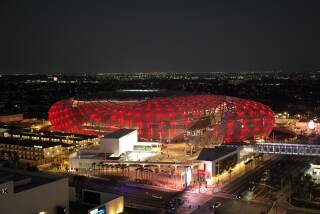Laserium Looks to Brighter Future
- Share via
It’s been 28 years since a newfangled entertainment and art medium dubbed Laserium firstcalled the Griffith Observatory home.
Today, Ivan Dryer--the founder and president of Laser Images Inc., Laserium’s parent company--calls his observatory shows featuring laser lights and images set mostly to rock music the longest-running theatrical production in Southern California.
But this enduring partnership will end early next year as both the Griffith Observatory and Laserium modernize their presentations for the 21st century.
The Griffith Observatory will close its doors for several years to embark on extensive remodeling costing about $63 million--and Laserium is moving out. The planetarium theater will be rebuilt to accommodate state-of-the-art, digital-animation science presentations. The addition of a lower floor with exhibit space and a 200-seat theater designed for more conventional lecture and film presentations will also be part of the renovation. When the observatory reopens in late 2004, it will be a science-only facility.
So the next few months offer the last time to see the laser show in this setting. The observatory is tentatively scheduled to shut down in January; Dryer, the creator of the laser-rock medium, hopes to have a radically new laser show ready to go immediately after that at a yet-to-be-announced facility in Los Angeles.
“The environment [at Griffith Park] is wonderful,” Dryer said in an interview at Laser Images’ office in Van Nuys. “It’s a great place to have a theater and a great place to go to hang out. We certainly will miss the observatory. There is a lot of nostalgia there for me. On the other hand, we’re really looking forward to a new venue and a new edition of Laserium.”
Laserium’s future venue is expected to be much smaller than the 600-seat Planetarium Theater. Daytime shows will be interactive, with music and lights being shaped by the body movements of the patrons. Evening performances will feature story-driven performances involving light, laser and computer images set primarily to electronic music. (Laserium shows at the Griffith Observatory are offered only at night.)
Though Laserium’s technology has evolved since its early ‘70s beginnings, the design of its Planetarium shows has essentially remained the same. Patrons sit in the theater’s concentrically arranged seats. Imaginative laser designs and images are then splashed across the facility’s large, domed ceiling.
Music plays an essential role in the Laserium experience. Shows have been presented to popular music by such artists as Led Zeppelin and Pink Floyd. The latter band’s “Dark Side of the Moon” album has been the basis for Laserium’s most popular show over the years.
Dryer expects business to pick up substantially as the public becomes more aware that the original Laserium format is being discontinued. But attendance has been moving in the other direction in recent years.
When Laserium first appeared, it represented a new and exciting form of technology, art and entertainment. Dryer remembers having to turn away 500 people for one of Laserium’s 1973 shows. At its peak, Laser Images was presenting laser performances in 45 cities around the world.
But by the 1990s, the audience for Laserium had begun to subside substantially. Dryer says tremendous advances in movie special effects contributed to the declining interest in Laserium.
“When we started, there was ‘Star Wars’ in 1977 and maybe ‘Blade Runner’ in 1982,” Dryer explains. “There were just a few special-effects-laden films. Now you see [new ones] every week. It’s harder and harder, with the computer graphics that are available now [in commercial films], for us to present something that’s state-of-the-art. We have to change horses.”
Expanding Its Musical Appeal
The fragmenting pop music market also has affected Laserium; it’s more difficult to find music that appeals to broad groups. So Laserium has had to expand its musical menu, which changes monthly. In May it will be offering the perennial favorite “Dark Side of the Moon,” “Laser Rock 3D,” “The Beatles,” “Nine Inch Nails 3D,” “Totally ‘80s 3D” and “Laser Visions.”
“Dark Side of the Moon” appeals most to early Laserium fans. “Laser Rock 3D” skews much younger, with a potpourri of music from relative newcomers such as Green Day and the Cranberries. The much mellower “Laser Visions” offers various ambient and new age sounds. “Nine Inch Nails” features the music of the often harsh-sounding industrial-rock band of the same name. “Totally ‘80s 3D” appeals to rock fans who grew up during that decade. “The Beatles,” featuring music by the Fab Four, is perhaps the show with the widest generational appeal.
“The Beatles show is really big,” says Tim Barrett, one of the laser artists who orchestrates shows at the Planetarium. “It’s amazing how many parents have raised their young kids on the Beatles.”
Appealing to young people is crucial in developing the new show, Dryer says.
“It’s going to be so overwhelming an experience,” he says. “There will be gigantic images all over your environment. Kids today want to be assaulted. They want it bigger, louder and brighter, and that’s what we’re going to give them.”
*
* Laserium, Griffith Observatory, 2800 Observation Road, Los Angeles. $8; ages 5-12 and 55 and older, $7. No children under 5. Add $1 to 3-D laser shows, which includes 3-D glasses. May schedule: “The Beatles”: Saturdays and Sundays at 6 p.m.; “Dark Side of the Moon”: Sundays at 8:45 p.m.; “Laser Rock 3D”: Tuesdays-Fridays, 6 p.m.; “Totally ‘80s 3D”: Tuesdays, Wednesdays, Fridays, Saturdays at 8:45 p.m.; “Laser Visions”: Thursdays at 8:45 p.m.; “Nine Inch Nails”: Fridays and Saturdays at 9:45 p.m. Closed Mondays. (818) 997-3624 or https://www.laserium.com.
More to Read
The biggest entertainment stories
Get our big stories about Hollywood, film, television, music, arts, culture and more right in your inbox as soon as they publish.
You may occasionally receive promotional content from the Los Angeles Times.










